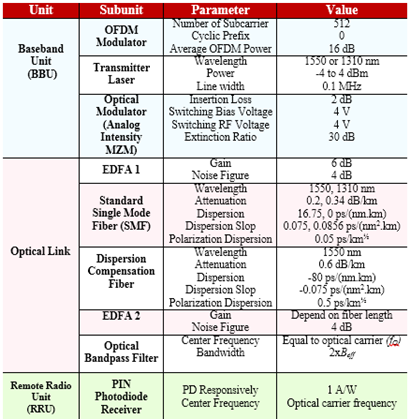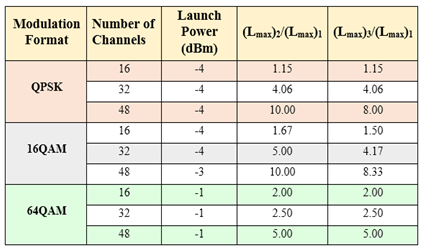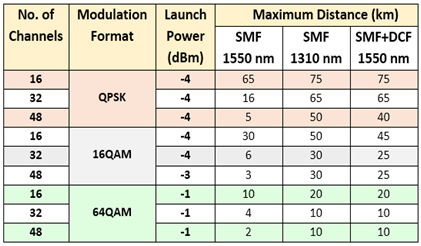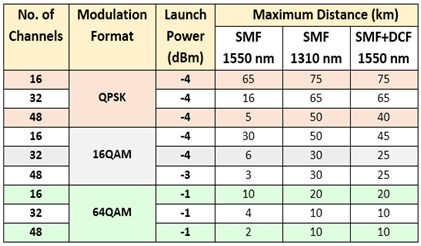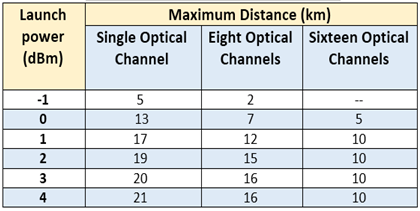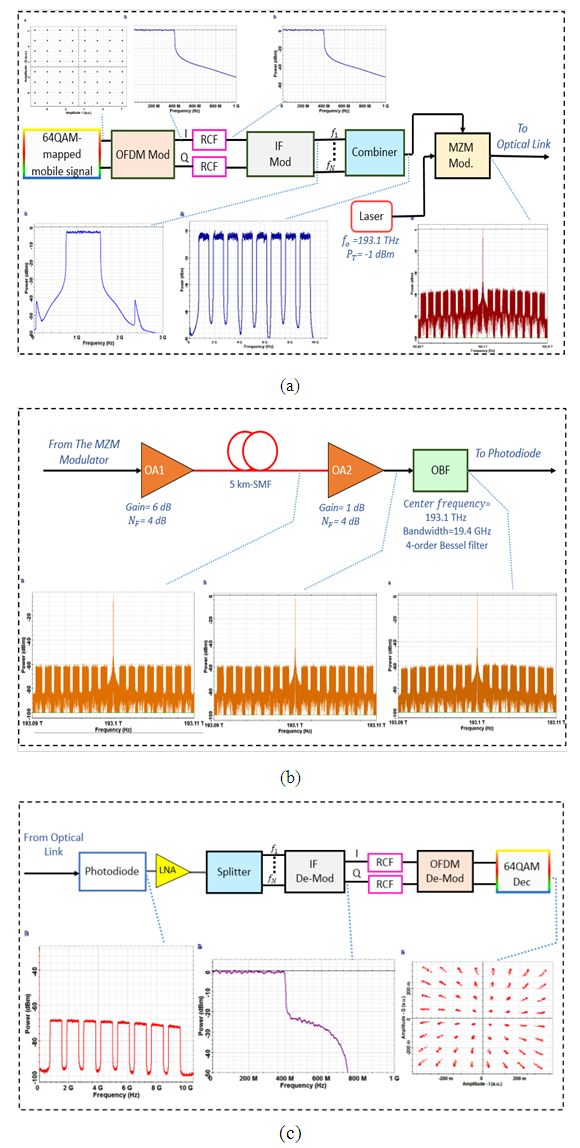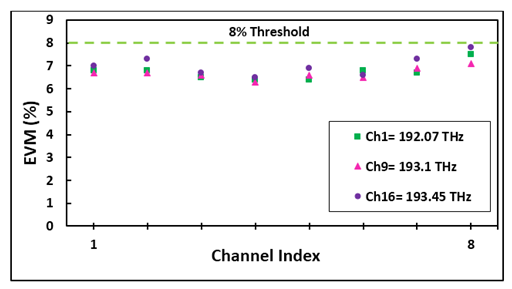| [1] | N. U. Hasan, W. Ejaz, N. Ejaz, H. S. Kim, A. Anpalagan, and M. Jo, "Network selection and channel allocation for spectrum sharing in 5G heterogeneous networks", IEEE Access, vol. 4, pp. 980-992, 2016. |
| [2] | C. Ranaweera, E. Wong, A. Nirmalathas, C. Jayasundara, and C. Lim, "5G C-RAN With Optical Fronthaul: An Analysis From a Deployment Perspective", IEEE Journal of Lightwave Technology, vol. 36, no. 11, pp. 2059-2068, 2018. |
| [3] | M. Fiorani, A. Rostami, L. Wosinska, and P. Monti, "Abstraction models for optical 5G transport networks", Journal of Optical Communications and Networking, vol. 8, no. 9, pp. 656-665, September 2016. |
| [4] | I. F. Akyildiz, S. C. Lin, and P. Wang, "Wireless software-defined networks (W-SDNs) and network function virtualization (NFV) for 5G cellular systems: An overview and qualitative evaluation," Computer Networks, vol. 93, no. 1, p. 66–79, December 2015. |
| [5] | S. Zhang, Q. Wu, S. Xu, and G. Y. Li, "Fundamental green tradeoffs: progresses, challenges, and impacts on 5G networks," IEEE Communications Surveys and Tutorials, vol. 19, pp. 33-56, 2017. |
| [6] | M. Ataee and A. Mohammadi, "Energy-efficient resource allocation for adaptive modulated MIMO–OFDM heterogeneous cloud radio access networks", Wireless Personal Communications, vol. 95, no. 4, pp. 4847-4866, Augest 2017. |
| [7] | S. Iezekiel, "Radio-over-fiber technology and devices for 5G: an overview", Broadband Access Communication Technologies, vol. 9772, 2016. |
| [8] | C. I. Badoi, N. Prasad and R. Prasad, "Virtualization and scheduling methods for 5G cognitive radio based wireless networks," Wireless Personal Communications, vol. 89, no. 2, pp. 599–619, July 2016. |
| [9] | A. N. Rashed and M. S. Tabbour, "Suitable optical fiber communication channel for optical nonlinearity signal processing in high optical data rate systems", Wireless Personal Communications, vol. 97, no. 1, pp. 397–416, November 2017. |
| [10] | S. Guo, S. Shao, Y. Wang, and H. Yang, "Cross stratum resources protection in fog-computing-based radio over fiber networks for 5G services", Optical Fiber Technology, vol. 37, pp. 61-68, September 2017. |
| [11] | G. Kalfas, J. Vardakas, L. Alonso, C. Verikoukis, and N. Pleros, "Non-saturation delay analysis of medium transparent MAC protocol for 5G 60 GHz fiber-wireless towards 5G mmWave networks", Journal of Lightwave Technology, vol. 85, no. 18, pp. 3945-3955, September 2017. |
| [12] | S. A. Haider, M. J. Zhao, and I. Ngebani, "MIMO beamforming architecture in millimeter wave communication systems", Wireless Personal Communications, vol. 97, no.2, pp. 2597–2616, November 2017. |
| [13] | A. Ichkov, V. Atanasovski, and L. Gavrilovska, "Potentials for application of millimeter wave communications in cellular networks", Wireless Personal Communications, vol. 92, no. 1, pp. 279–295, January 2017. |
| [14] | Y. Niu, Y. Li, D. Jin, Su, and A. V. Vasilakos, "A survey of millimeter wave communications (mmWave) for 5G: opportunities and challenges", Wireless Networks, vol. 21, no. 8, pp. 2657-2676, November 2015. |
| [15] | M. Xiao, S. Mumtaz, Y. Huang, L. Dai, Y. Li, M. Matthaiou, G. K. Karagiannidis, E. Bjornson, K. Yang, I. C. Lin, and A. Ghosh, "Millimeter wave communications for future mobile networks, part I", IEEE Journal on Selected Areas in Communications, vol. 35, no. 7, pp. 1425-1431, July 2017. |
| [16] | P. T. Dat, A. Kanno, N. Yamamoto, and T. Kawanishi, "5G transport and broadband access networks: the need for new technologies and standards", ITU Kaleidoscope: Trust in the Information Societ, Barcelona, Spain, 2015. |
| [17] | J. Deng, O. Tirkkonen, R. F. Hollanti, T. Chen, and N. Nikaein, "Resource allocation and interference management for opportunistic relaying in integrated mmWave/sub-6 GHz 5G networks", IEEE Communications Magazine, vol. 55, no. 6, pp. 94-101, June 2017. |
| [18] | A. Alnoman and A. Anpalagan, "Towards the fulfillment of 5G network requirements: technologies and challenges", Telecommunication Systems, vol. 65, no. 1, pp. 101–116, May 2017. |
| [19] | K. Sakaguchi, E. M. Mohamed, H. Kusano, and S. Namba, "Millimeter-wave wireless LAN and its extension toward 5G heterogeneous networks", IEICE Transactions on Communications, vol. E98-B, no. 10, pp. 1932-1947 October 2015. |
| [20] | M. Tesanovic and M. Nekovee, "mmWave-based mobile access for 5G: key challenges and projected standards and regulatory roadmap", Global Communications Conference (GLOBECOM), California, USA, 2015. |
| [21] | J. Beas, G. Castañón, F. Orozco, I. Aldaya, A. A. Zavala, and G. Campuzano, "Knowledge-based framework for the design of millimeter-wave (60 GHz) radio over fiber land networks", Photonic Network Communications, vol. 30, no. 2, pp. 234-260, October 2015. |
| [22] | F. C. Abrecht, R. Bonjour, S. Welschen, A. Josten, B. Baeuerle, D. Hillerkuss, M. Burla, and J. Leuthold, "Pre-equalization technique enabling 70 Gbit/s photonic-wireless link at 60 GHz", Optics Express, vol. 24, no. 26, pp. 30350-30359, 2016. |
| [23] | J. Isabona and V. M. Srivastava, "Downlink massive MIMO systems: achievable sum rates and energy efficiency perspective for future 5G systems", Wireless Personal Communications, vol. 96, no. 2, pp. 2779-2796, September 2017. |
| [24] | G. Liu, X. Hou, F. Wang, J. Jin, H. Tong, and Y. Huang, "Achieving 3D-MIMO with massive antennas from theory to practice with evaluation and field trial results", IEEE Systems Journal, vol. 11, no. 1, pp. 62-71, March 2017. |
| [25] | L. Wang, H. Q. Ngo, M. Elkashlan, T. Q. Duong, and K. K. Wong, "Massive MIMO in spectrum sharing networks: achievable rate and power efficiency", IEEE Systems Journal, vol. 11, no. 1, pp. 20-31, March 2017. |
| [26] | R. Mahapatra, "Participation of optical backbone network in successful advancement of wireless network," Wireless Personal Communications, vol. 96, no. 3, pp. 3463-3481, October 2017. |
| [27] | O. Hayat, R. Ngah, and Y. Zahedi, "Cooperative device-to-device discovery model for multiuser and OFDMA network base neighbour discovery in in-band 5G cellular networks," Wireless Personal Communications, pp. 1-15, August 2017. |
| [28] | K. Habel, M. Koepp, S. Weide, L. Fernandez, C. Kottke, and V. Jungnickel, "100G OFDM-PON for converged 5G networks: from concept to real-time prototype", Optical Fiber Communications Conference (OFC), California, USA, 2017. |
| [29] | V. D. Esposti, F. Fuschini, R. S. Thomae, R. Mueller, D. Dupleich, K. Haneda, J. M. M. G. Pardo, J. P. Garcia, D. P. Gaillot, S. Hur, and M. Nekovee, "Millimeter-wave propagation: characterization and modeling toward fifth-generation systems", IEEE Antennas and Propagation Magazine, vol. 58, no. 6, pp. 115-127, December 2016. |
| [30] | K. Sakaguchi, G. K. Tran, H. Shimodaira, S. Nanba, T. Sakurai, K. Takinami, I. Sidud, E. C. Strinati, A. Capone, I. Karls, R. Arefi, and T. Hauste, "Millimeter-wave evolution for 5G cellular networks", IEICE Transactions on Communication, vol. E98-B, no. 3, pp. 388-402, March 2015. |
| [31] | T. Yang, M. Gao, J. Qian, J. Zhang, and W. Chen "A flexible millimeter-wave radio-over-fiber system for various transmission bit rate", Optics and Laser Technology, vol. 96, pp. 132-140, November 2017. |
| [32] | X. Yu, M. Matsuura, and Y. Yamao, "Composite effect of E/O nonlinearity and optical echo on EPWM-OFDM transmission in radio over fiber channel", Wireless Personal Communications, vol. 93, no. 3, pp. 647–660, April 2017. |
| [33] | M. Kong and W. Zhou, "Delivery of 12QAM single carrier signal in a MIMO radio-over-fiber system at 60 GHz", IEEE Photonics Journal, vol. 9, no. 3, June 2017. |
| [34] | Y. Yu, C. Ranaweera, C. Lim, L. Guo, Y. Liu, A. Nirmalathas, and E. Wong, "Hybrid fiber-wireless network: an optimization framework for survivable deployment", IEEE Journal of Optical Communications and Networking, vol. 9, no. 6, pp. 466-478, June 2017. |
| [35] | S. Mikroulis, O. Omomukuyo, M. P. Thakur, and J. E. Mitchell, "Investigation of a SMF-MMF link for a remote heterodyne 60-GHz OFDM RoF based gigabit wireless access topology", IEEE Journal of Lightwave Technology, vol. 32, no. 20, pp. 3645-3653, October 2014. |
| [36] | M. Fiorani, S. Tombaz, J. Martensson, B. Skubic, L. Wosinska, and P. Monti, "Modeling energy performance of C-RAN with optical transport in 5G network scenarios", IEEE Journal of Optical Communications and Networking, vol. 8, no. 11, pp. B21-B34, November 2016. |
| [37] | F. Musumeci, C. Bellanzon, N. Carapellese, M. Tornatore, A. Pattavina, and S. Gosselin, "Optimal BBU placement for 5G C-RAN deployment over WDM aggregation networks", IEEE Journal of Lightwave Technology, vol. 34, no. 8, pp. 1963-1970, April 2016. |
| [38] | W. HY, C. YC, and L. GR, "Remote beating of parallel or orthogonally polarized dual-wavelength optical carriers for 5G millimeter-wave radio-over-fiber link", Optic Express, vol. 42, no. 16, pp. 17654-17669, August 2016. |
| [39] | C. Y. Lin, Y. C. Chi, C. T. Tsai, H. Y. Wang, H. Y. Chen, M. Xu, G. K. Chang, and G. R. Lin, "Millimeter-wave carrier embedded dual-color laser diode for 5G MMW of Link", IEEE Journal of Lightwave Technology, vol. 35, no. 12, pp. 2409-2420, June 2017. |
| [40] | C. Lin, Y. C. Chi, C. T. Tsai, H. Y. Chen, and J. R. Lin, "Two-color laser diode for 54-Gb/s fiber-wired and 16-Gb/s MMW wireless OFDM transmissions", Photonics Research, vol. 5, no. 4, pp. 271-279, August 2017. |
| [41] | D. Boviz, C. S. Chen, and S. Yang, "Effective design of multi-user reception and fronthaul rate allocation in 5G cloud RAN", IEEE Journal on Selected Areas in Communications, vol. 35, no. 8, pp. 1825-1836, August 2017. |
| [42] | H. Zhang, Y. Dong, J. Cheng, Md. J. Hossain, and V. C. M. Leung, "Fronthauling for 5G LTE-U ultra dense cloud small cell networks ", IEEE Wireless Communications , vol. 23, no. 6, pp. 48-53, December 2016. |
| [43] | M. Sung, S-H Cho, H. S. Chung, S. M. Kim, and J. H. Lee, "Investigation of transmission performance in multi-IFoF based mobile fronthaul with dispersion-induced intermixing noise mitigation," Optic Express, vol. 25, no. 8, pp. 9346-9357, April 2017. |
| [44] | M. Xu, F. Lu, J. Wang, L. Cheng, D. Guidotti, and G-K Chang, "Key technologies for next-generation digital RoF mobile fronthaul with statistical data compression and multiband modulation", IEEE Journal of Lightwave Technology, vol. 35, no. 17, pp. 3671-3679, September 2017. |
| [45] | T. Pfeiffer, "Next generation mobile fronthaul and midhaul architectures", Journal of Optical Communications and Networking, vol. 7, no. 11, pp. B38-B45, November 2015. |
| [46] | X. Liu, H. Zeng, N. Chand, and F. Effenberger, "Efficient mobile fronthaul via DSP-based channel aggregation", IEEE Journal of Lightwave Technology, vol. 34, no. 6, pp. 1556-1564, March 2016. |
| [47] | D. Chitimalla, K. Kondepu, L. Valcarenghi, M. Tornatore, and B. Mukherjee, "5G fronthaul-latency and jitter studies of CPRI over ethernet", IEEE Journal of Optical Communications and Networking, vol.9, no. 2, pp. 172-182, February 2017. |
| [48] | L. Valcarenghi, K. Kondepu, and P. Castoldi, "Time- versus size-based CPRI in ethernet encapsulation for next generation reconfigurable fronthaul", IEEE Journal of Optical Communications and Networking, vol. 9, no. 9, pp. D64-D73, 2017. |
| [49] | H. Zeng, X. Liu, S. Megeed, N. Chand, and F. Effenberger, "Real-time demonstration of CPRI-compatible efficient mobile fronthaul using FPGA", IEEE Journal of Lightwave Technology, vol. 35, no. 6, pp. 1241-1247, March 2017. |
| [50] | X. Liu, H. Zeng, N. Chand, and F. Effenberger, "Efficient mobile fronthaul via DSP-based channel aggregation", IEEE Journal of Lightwave Technology, vol. 34, no. 6, pp. 1556-1564, March 2016. |
| [51] | M. Sung, S-H Cho, H. S. Chung, S. M. Kim, and J. H. Lee, "Investigation of transmission performance in multi-IFoF based mobile fronthaul with dispersion-induced intermixing noise mitigation" Optic Express, vol. 25, no. 8, pp. 9346-9357, April 2017. |
| [52] | F. Lu, M. Xu, L. Cheng, J. Wang, S. Shen, J. Zhang, and G-K Chang, "Sub-band pre-distortion for PAPR reduction spectral efficient 5G mobile fronthaul", IEEE Photonic Technology Letters, vol. 29, no. 1, pp. 122-125, January 2017. |
| [53] | Y. Tian, K-L Lee, C. Lim, and A. Nirmalathas, "60 GHz analog radio-over-fiber fronthaul investigations", IEEE Journal of Lightwave Technology, vol. 35, no.19, pp. 4304-4310, October 2017. |
| [54] | P. Aggarwal and V. A. Bohara, "On the multiband carrier aggregated nonlinear LTE-A system", IEEE Access, vol. 5, pp. 16930-16943, 2017. |
| [55] | S. Lange, S. Wolf, J. Lutz, L. Altenhain, R. Schmid, R. Kaiser, C. Koos, S. Randel, and M. Schell, "100 GBd intensity modulation and direct detection with an InP-based monolithic DFB laser Mach-Zehnder modulator", Optical Fiber Communications Conference and Exhibition (OFC), California, USA, 2017. |
| [56] | N. H. Zhu, Z. Shi, Z. K. Zhang, Y. M. Zhang, C. W. Zou, Z. P. Zhao, Y. Liu, W. Li, and M. Li, "Directly modulated semiconductor lasers", IEEE Journal of Selected Topics in Quantum Electronics, vol. 24, no. 1, February 2018. |
| [57] | G. N. Liu, L. Zhang, T. Zuo, Q. Zhang, J. Zhou, and E. Zhou, "IM/DD transmission techniques for emerging 5G fronthaul, DCI and metro applications", Optical Fiber Communications Conference and Exhibition (OFC), California, USA, 2017. |
| [58] | T. Shao, E. P. Martin, P. M. Anandarajah, and L. P. Barry, "60-GHz direct modulation-direct detection OFDM-RoF system using gain-switched laser", IEEE Photonics Technology Letters, vol. 27, no. 2, pp. 193-196, January 2015. |
| [59] | S. A. Khwandah, J. P. Cosmas, I. A. Glover, P. I. Lazaridis, N. R. Prasad, and Z. D. Zaharis, "Direct and external intensity modulation in OFDM RoF links", IEEE Photonics Journal, vol. 7, no. 4, August 2015. |
| [60] | X. Liu, F. Effenberger, N. Chand, L. Zhou, and H. Lin, "Efficient mobile fronthaul transmission of multiple LTE-A signals with 36.86-Gb/s CPRI-equivalent data rate using a directly-modulated laser and fiber dispersion mitigation", Asia Communications and Photonics Conference, Shanghai China, 2014. |
| [61] | X. Liu, H. Zeng, N. Chand, and F. Effenberger, “Experimental demonstration of high-throughput low-latency mobile fronthaul supporting 48 20-MHz LTE signals with 59-Gb/s CPRI-equivalent rate and 2-μs processing latency,” European Conference Optical Communication, Valencia, Spain, 2015. |
| [62] | M. Sung, S-H Cho, K. S. Kim, H-K Kwon, B-S Kang, D S Oh, D-S Lyu, H. Lee, S. M. Kim, J. H. Lee, and H. S. Chung, "Demonstration of IFoF based 5G mobile fronthaul in 28 GHz millimeter wave testbed supporting giga-bit mobile services", Optical Fiber Communications Conference and Exhibition (OFC), California, USA, 2017. |
| [63] | Zh. Yu, Y. Lou, M. Chen, H. Chen, S. Yang, and S. Xie, "Adaptive three-dimensional optimization for optical direct-detection OFDM", IEEE Journal of Lightwave Technology, vol. 35, no. 9, pp. 506-1512, May 2017. |
| [64] | J. Zhang, Y. Zheng, X. Hong, and C. Guo, "Increase in capacity of an IM/DD OFDM-PON using super-nyquist image-induced aliasing and simplified nonlinear equalization", IEEE Journal of Lightwave Technology, vol. 35, no. 16, pp. 4105-4113, October 2017. |
| [65] | J. Shi, Y. Zhou, Y. Xu, J. Zhang, J. Yu, and N. Chi, "200-Gbps DFT-S OFDM using DD-MZM-based twin-SSB with a MIMO-volterra equalizer", IEEE Photonics Technology Letters, vol. 29, no. 14, pp. 1183-1186, July 2017. |
| [66] | J-W Wu, Q. Qiu, X-P Zhang, and Y. H. Won, "Simultaneous generation of microwave, millimeter-wave, and terahertz photonic signal based on two-color semiconductor laser subject to single-beam optical injection", IEEE Journal of Selected Topics in Quantum Electronics, vol. 23, no. 4, August 2017. |
| [67] | O. Strobel, “Optical and microwave technologies for telecommunication networks”, John Wiley & Sons, Ltd, United Kingdom, 2016. |
| [68] | H-Y Chen, Y-C Chi, C-Y Lin, and G-R Lin, "Adjacent channel beating with recombined dual-mode colorless FPLD for MMW-PON", IEEE Journal of Selected Topics in Quantum Electronics, vol. 23, no. 6, December 2017. |
| [69] | X. Liu, F. Effenberger, N. Chand, L. Zhou, and H. Lin, "Demonstration of bandwidth-efficient mobile fronthaul enabling seamless aggregation of 36 E-UTRA-like wireless signals in a single 1.1-GHz wavelength channel", Optical Fiber Communication Conference, paper M2J.2, 2015. |
| [70] | M. Hudlicka, C. Lundstrom, D. A. Humphreys, and I. Fatadin, “BER estimation from EVM for QPSK and 16-QAM coherent optical systems”, IEEE, 6th International Conference on Photonics (ICP), Kuching, Malaysia, 2016. |
| [71] | G. H. Smith, D. Novak, and Z. Ahmed, “Overcoming chromatic-dispersion effects in fiber-wireless systems incorporating external modulators”, IEEE Transactions on Microwave Theory and Techniques, vol. 45, no. 8, pp. 1410-1415, Aug. 1997. |






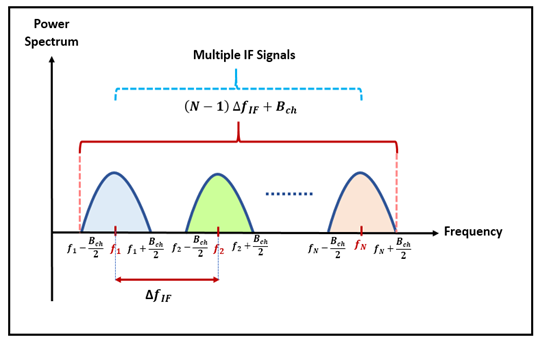






 Abstract
Abstract Reference
Reference Full-Text PDF
Full-Text PDF Full-text HTML
Full-text HTML

